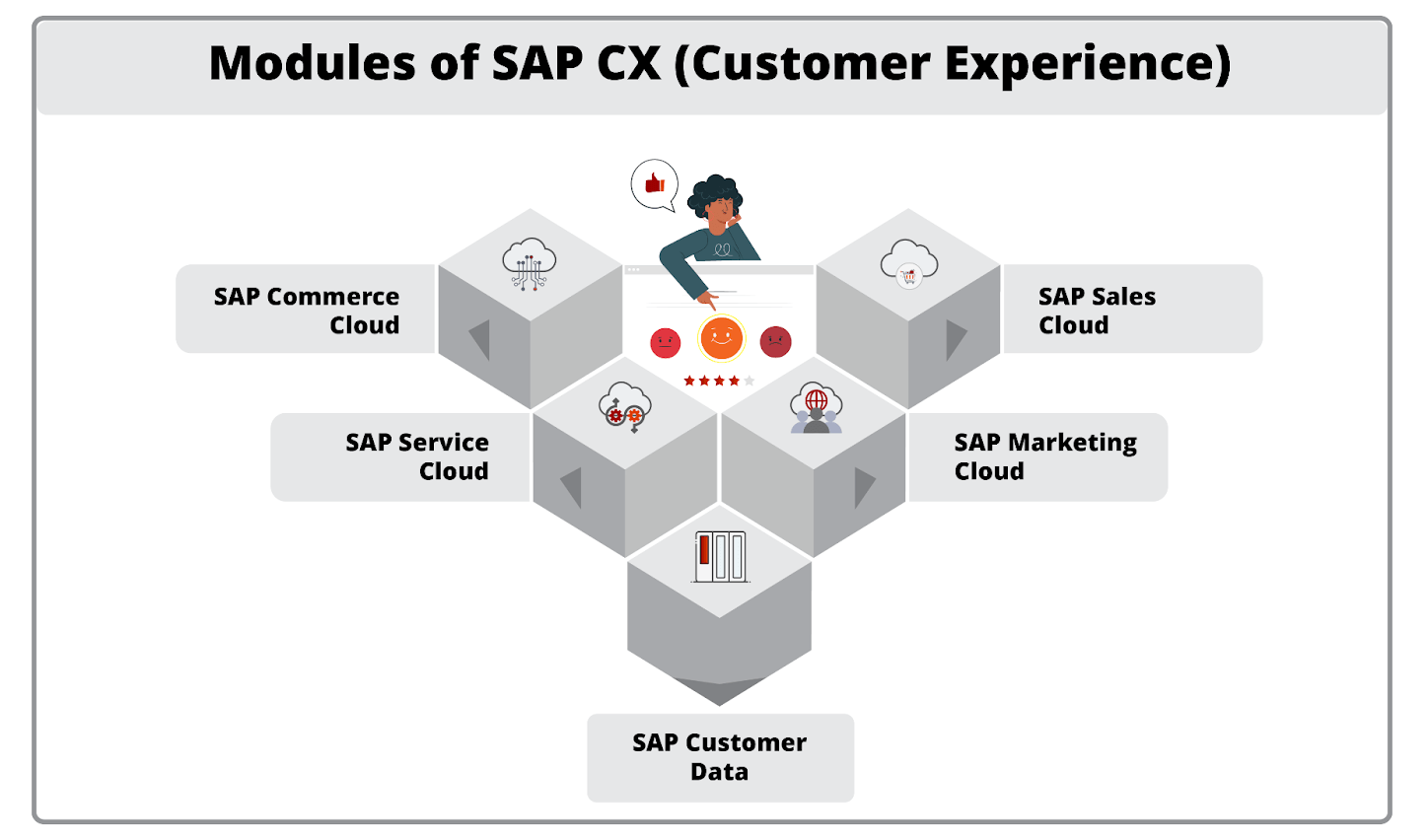Customer Experience Analytics (CX Analytics): A Deep Dive into SAP CX

In today’s increasingly competitive industry, understanding your consumers is important to success.
This is where customer experience analytics comes in.
This comprehensive blog will serve as your guide, guiding you through the complexities of CX analytics and assisting you in harnessing its revolutionary power. Whether you’re a CX expert or just getting started, this blog will provide you with the information and resources you need to revolutionize your customer experience strategy.
So let’s get started with What Customer Experience is….
The whole perception and engagement that consumers have with a brand, product, or service during their entire journey with that organization is referred to as customer experience (CX).
Importance of customer experience
| Without Customer Experience | With Customer Experience |
| Reduced customer satisfaction, resulting in dissatisfaction and negative feedback. | Improved customer satisfaction, leading to positive feedback and loyalty. |
| Lack of adequate data capture method for sales-related information in their reporting | Accelerates your businesses to exceptional customer experiences and digital operations |
| Difficulties in visualizing and modeling sales funnels on a quarterly, monthly, or annual basis. | Analyzes your sales pipeline with ease, whether it’s quarterly, monthly, or yearly with Sales & Service cloud |
| Due to a lack of relevant data, it is difficult to correctly monitor and analyze sales success. | Advanced reporting system that seamlessly captures and organizes all your sales data. |
| Utilization of customer insights and analytics for personalized marketing and service. | Limited ability to provide personalized experiences and targeted marketing. |
| Improved operational efficiency and resource allocation. | Reduced efficiency and misallocation of resources. |
Challenges in Delivering Exceptional Customer Experience
Delivering an exceptional customer experience is not without its difficulties. Among these difficulties are:
- Data Management:
With an increase of consumer data from a variety of sources, managing and analyzing this data to generate useful insights can be difficult.
- Personalization:
Customers want personalized experiences that respond to their individual requirements and interests. This can be difficult to achieve on a large scale.
- Omnichannel Engagement:
Customers interact with businesses via a number of channels, such as websites, social media, mobile applications, and others. It is vital to maintain consistency across all platforms.
- Real-time Responsiveness:
Customers demand quick responses to their queries and concerns. Manual processes can hinder timely interactions.
- Proactive Support:
Anticipating client demands and fixing issues before they develop is difficult without the correct tools.
Benefits of Customer Experience Analytics:
CX (Customer Experience) Analytics provides a useful compass for navigating the complicated world of current customer behavior. It provides several strategic benefits that have a direct impact on a company’s bottom line.
- Increase Customer Retention:
Understanding and improving the customer experience leads to increased customer satisfaction. As a consequence, fostering client loyalty and retention is simple. Retaining existing consumers is both cost-effective and beneficial to income creation.
- Boost Revenue Growth:
More clients equals more income for the firm. A great customer experience frequently leads to increased client lifetime value. Customers that have a positive experience are more likely to spend more, make repeat purchases, and connect with the brand, increasing total revenue growth.
- Reduced Customer Turnover:
Customer churn, or the loss of consumers to rivals, can be costly for firms. CX Analytics can help in identifying the causes of churn and providing insights on how to retain clients. Businesses can reduce turnover and boost client retention by addressing these challenges.
- Increase Your Competitive Advantage:
Over 75% of firms consider customer experience to be a major differentiator. Are you one of the 75%? In today’s competitive market, a superior customer experience can set your business apart from the competition. Companies that prioritize customer experience analytics are better positioned to meet or exceed customer expectations, offering them a competitive advantage.
- Increased Marketing ROI:
Businesses can more accurately segment their client base using CX Analytics. This enables targeted marketing efforts with greater conversion rates since messages and offers are tailored to the individual requirements and preferences of each segment.
Lets know more about Customer Experience analytics:
Customer experience analytics is the practice of collecting, analyzing, and interpreting data about a company’s goods, services, and touchpoints. It comprises various methods and tactics to collect data from many sources, including as consumer feedback, surveys, website analytics, social media monitoring, and more.
How to Analyze CX: Best Practices and Strategies
Establish Your Goals: Before you begin, define the goals and objectives of your customer experience study.
What areas of the customer’s journey do you wish to evaluate? Do you want to increase customer happiness, uncover pain areas, or assess the impact of recent changes to your goods or services?
Collect Information: Collect and store data from surveys, feedback forms, and social media in one location for convenient access and analysis.
Advanced Analytics : To get meaningful insights from your data, use strong analytics tools To extract insights from the obtained data, use data analysis tools and methodologies. Examine the data for patterns, trends, and correlations to discover areas where the customer experience can be improved.
Text Analytics and Sentiment Analysis: To analyze consumer sentiment, extract insights from unstructured data like survey replies and social media comments.
Implement Real-time Monitoring: Track client input in real-time to fix issues quickly and provide a consistent experience.
Data Visualization: Use charts and graphs to visualize data in order to discover patterns and effectively convey findings.
Segmenting customer: Segment your consumers based on common features to personalize your approach and increase satisfaction.
Key Customer Experience KPIs: Identify and define critical metrics that assess customer happiness and loyalty, such as NPS, CSAT, and CES.
Customer Journey Map: Make a complete customer journey map that depicts the full client experience, from the first point of contact through post-purchase contacts. Include all essential touchpoints, consumer emotions, and pain points experienced along the journey.
So, are you curious about the best customer experience solution?
SAP Customer Experience is a suite of solutions that enhance businesses’ interactions with customers by enabling them to provide a seamless experience across sales, marketing, commerce, and service, nurturing customer loyalty and driving business success.
Now, Let’s get into the modules of SAP CX:
SAP Commerce Cloud is a flexible e-commerce system that enables businesses to create and develop their online storefronts. It includes capabilities for managing product catalogs, content, marketing automation, and customer segmentation, allowing businesses to develop aesthetically beautiful and functioning online stores that adapt to changing e-commerce trends.
SAP Sales Cloud is intended to improve and streamline the sales process. It provides lead management, opportunity management, sales performance statistics, and other capabilities. This module provides sales teams with the data and tools they need to complete deals more quickly and create long-term client connections.
SAP Service Cloud focuses on providing excellent customer service and support. It has capabilities like case management, knowledge base management, self-service portals, and omnichannel assistance. This module enables businesses to deliver prompt and effective customer service, resulting in increased customer satisfaction.
SAP Marketing Cloud focuses on developing data-driven marketing initiatives. It comprises consumer segmentation, campaign management, lead nurturing, and marketing analytics. Businesses can utilize this module to send highly targeted and personalized marketing communications to their customers.
SAP Customer Data Cloud is primarily concerned with identification and consent management. It has features like single sign-on, registration and login, profile and preference management, and consent tracking. This module helps businesses in ensuring data privacy compliance and building consumer confidence.
Last thought:
In an era where client satisfaction can be a company’s most valuable asset, using Customer Experience Analytics Software is no longer an option—it is a desire. We, at KaarTech, can help your company acquire deep insights into your consumers, optimize its processes, and ultimately provide a customer experience that inspires happiness and loyalty. Contact us by clicking here…
FAQ’s
What is Customer Experience (CX)?
Customer Experience refers to the overall interaction and perception consumers have with a brand throughout their journey. It encompasses every touchpoint and engagement with a product or service.
Why is Customer Experience Analytics Important?
It offers insights crucial for understanding customer behavior, enhancing satisfaction, boosting revenue, and gaining a competitive edge. It helps in retaining customers, increasing revenue, and optimizing resources.
What are the Main Challenges in Delivering Exceptional CX?
Challenges include managing vast consumer data, achieving personalized experiences at scale, ensuring consistency across various channels, providing real-time responses, and proactively addressing customer needs.
What are the Key Strategies for CX Analytics?
Strategies involve setting clear goals, collecting and analyzing data comprehensively, utilizing advanced analytics and sentiment analysis, implementing real-time monitoring, visualizing data for patterns, segmenting customers, identifying crucial KPIs, and mapping the customer journey comprehensively.


